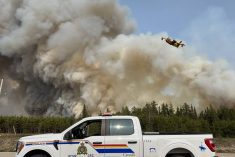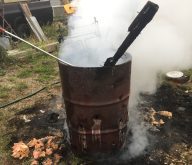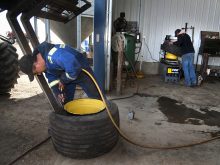Asthma, pneumonia and other respiratory illness can be triggered by farm hazards such as bacteria, chemicals and dust
The dust stirs on a windy day and Dave Broersma sits in the cab of his tractor a bit longer than most.
“I consciously have to wait until the dust settles and then get out. It affects me,” he said.
Broersma dealt with asthma symptoms for years on his small grain farm in Hague, Sask. He was diagnosed with asthma when he was young but farm dust exacerbated it.
Occupational asthma is one of the respiratory diseases Saskatchewan farmers face throughout the year.
Read Also

Nutritious pork packed with vitamins, essential minerals
Recipes for pork
Breathing in small particles in the air can trigger disease depending on the amount and type. Organic toxic dust syndrome and farmer’s hypersensitivity pneumonitis can also result.
Broesma’s symptoms were an inconvenience but also life threatening at times.
“You’d have some symptoms of like shortness of breath. You couldn’t sleep because you couldn’t breathe and then you’d end up going to the hospital,” he said.
The symptoms of occupational asthma include chest tightness, coughing and wheezing while FHP, formerly farmer’s lung, and OTDS have flu-like symptoms such as fever, chills and muscle pain.
The main difference between occupational asthma and FHP is a deeper irritation affecting the lung alveoli and a high hypersensitivity level accompanied by an immune response.
OTDS occurs by inhaling a large dose of moulds from spoiling forage or grain that are toxic, whereas FHP and occupational asthma are caused by continual inhalation causing irritation at different levels.
The ODTS will subside on its own, whereas the other two diseases go into remission until re-exposure.
Dust from shovelling grain bins could trigger an attack for Broesma, who would wear masks when needed and add specialized equipment when possible.
“I had flat bottom bins and then I made the decision to buy hopper bottom bins even though they were double the money just because I knew I didn’t want to shovel bins,” said Broesma.
Niels Koehncke, associate professor of occupational medicine with the Canadian Centre for Health and Safety in Agriculture, recommended protective wear and reduced exposures.
“Longer-term exposure, there’s more likelihood of disease over time so if it’s not recognized early there’s a greater chance that it becomes more disabling and harder to treat but it depends on the exposure,” he said.
Koehncke is also the chief occupational medical officer for the labour and workplace safety ministry that develops the Farm Safety Guide under the Occupational Health and Safety Act.
It outlines procedures and precautions for farmers to reduce their risks.
“Be aware of potential respiratory hazards in the work environment and farming environment, then try to assess those and see what can be done to limit your exposure… You can’t eliminate the risk but sometimes something can be done,” said Koehncke.
The guide suggests workplace inspections or walkabouts that focus on finding farm hazards.
Dr. Chris Clark, associate professor in large animal medicine at the Western College of Veterinary Medicine, said animals exposed to dust particles can also be susceptible to respiratory diseases.
“It’s very rare to get the respiratory diseases bouncing back and forth between the human and animal populations …. We do see what they refer to as reactive airway disease in horses (which) is an allergic reaction to fungal spores in hay, etc. and there are parallel diseases to that seen in humans,” he said.
Doctors diagnosing the disease must first look at the occupational history of the patient because the symptoms can overlap common viral illnesses or bronchitis.
Broesma visited his doctor every six months and continues to take his medication. He left grain farming and moved into dairy farming in B.C.’s Okanagan.
“It’s the only thing I know how to do, I’ve gone to school for it and I just love what I do. I can’t imagine life doing anything else,” he said.
“You realize as a person you have this problem and if I don’t take care of myself by going on these medications and doing that, then you’re not going to be around very long to continue farming.”

















